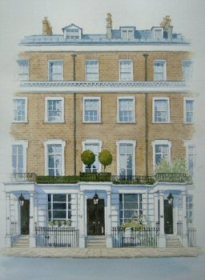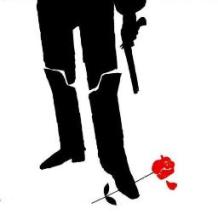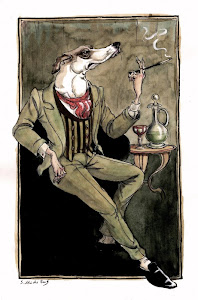 The world seems utterly foreign to me these days. It has changed enormously since I was a younger man, and not at all for the better. Fortunately not everything has succumbed to trendy fashion, and if one looks hard one can still find pockets of tradition and continuity.
The world seems utterly foreign to me these days. It has changed enormously since I was a younger man, and not at all for the better. Fortunately not everything has succumbed to trendy fashion, and if one looks hard one can still find pockets of tradition and continuity.This brings to mind the clothing store Hackett. It is amazing to me to realise Hackett has been around for 25 years. During school and university holidays, after obligatory visits to Gieves & Hawkes, Cording's, and New & Lingwood, I would join other young men on a pilgrimage to the Hackett shop on New King’s Road in Fulham. There I would acquire dress shirts (with spread collars and double cuffs), cords, and maybe a v-neck jumper or two. Later we would pick up vintage items, such as a pair of old Lobb brogues or a covert coat, at markets in Kensington and Camden.
 Mr. Hackett himself got his start selling vintage kit and in the early days the Hackett shop offered a limited selection of second-hand clothing. It became a mecca for betweeded Young Fogeys and Sloane Rangers, plus floppy-haired officers from the Guards and the HAC, some of whom would visit on their antique bicycle or in a VW Golf GTI. The Hackett brand grew into a major success. But by the early '90s the YF and SR sets started to move on. My sartorial interests, too, had changed, and I focused my attention on other sources. By the mid-'90s the Hackett polo shirt became linked to the shaven-headed 'yob' element.
Mr. Hackett himself got his start selling vintage kit and in the early days the Hackett shop offered a limited selection of second-hand clothing. It became a mecca for betweeded Young Fogeys and Sloane Rangers, plus floppy-haired officers from the Guards and the HAC, some of whom would visit on their antique bicycle or in a VW Golf GTI. The Hackett brand grew into a major success. But by the early '90s the YF and SR sets started to move on. My sartorial interests, too, had changed, and I focused my attention on other sources. By the mid-'90s the Hackett polo shirt became linked to the shaven-headed 'yob' element.My interest in Mr. Hackett has persisted over the years. A self-made man who left school at 17, he displays none of the vulgarity and weirdness of his American counterpart(s). He seems a quiet, decent Englishman who through hard work and diligence has created a successful business. It is a view corroborated by those who know him. His friend Ty Jeffries, in a profile in the Independent on Sunday newspaper, where Mr. Hackett writes a clothing advice column, has said: "He remains such a nice guy, very genuine, unpretentious." Mr. Hackett's success warrants a large measure of admiration and respect. Whether or not he receives it, is another question.
 Certainly his recent book, Mr. Classic (Thames & Hudson, 2006), was greeted in some quarters with confusion and misunderstanding. A collection of Mr. Hackett's newspaper columns, the book combines the author's musings on, say, Belgian shoes, dinner jackets, and cardigans, with a number of alarmingly creative photos of young men. The effort is a bit too artistic for my tastes, yet it does have undeniable appeal. The section on creative monogramming helped me look at my dress shirts in a new light, while his recollections of visiting Brooks Brothers and Belgian Shoes in Manhattan and Bel y Cia in Barcelona were amusing.
Certainly his recent book, Mr. Classic (Thames & Hudson, 2006), was greeted in some quarters with confusion and misunderstanding. A collection of Mr. Hackett's newspaper columns, the book combines the author's musings on, say, Belgian shoes, dinner jackets, and cardigans, with a number of alarmingly creative photos of young men. The effort is a bit too artistic for my tastes, yet it does have undeniable appeal. The section on creative monogramming helped me look at my dress shirts in a new light, while his recollections of visiting Brooks Brothers and Belgian Shoes in Manhattan and Bel y Cia in Barcelona were amusing.Just a quick note. The book cover features a photo of a young man wearing flip-flops with a dinner jacket, and somehow the notion has spread that Mr. Hackett himself approves of this look. He does not, as a reading of the relevant column confirms.
 Is it time to give Hackett a second look? Perhaps, if you are so inclined. I of course am allergic to change, to the extent that switching from, say, Gordon's gin to Bombay Sapphire and back again, is a traumatic event. Still, on re-examination a return to Hackett might seem as if I were re-embracing an old friend with whom I once spent wild days of youth. Hackett seems to be on the move to bigger and better things. So, I will give it some thought. In the meantime, in my recent discussions with company officials, I am given to understand Hackett will be available on these shores in the next year or so. Let me know what you think.
Is it time to give Hackett a second look? Perhaps, if you are so inclined. I of course am allergic to change, to the extent that switching from, say, Gordon's gin to Bombay Sapphire and back again, is a traumatic event. Still, on re-examination a return to Hackett might seem as if I were re-embracing an old friend with whom I once spent wild days of youth. Hackett seems to be on the move to bigger and better things. So, I will give it some thought. In the meantime, in my recent discussions with company officials, I am given to understand Hackett will be available on these shores in the next year or so. Let me know what you think.






























